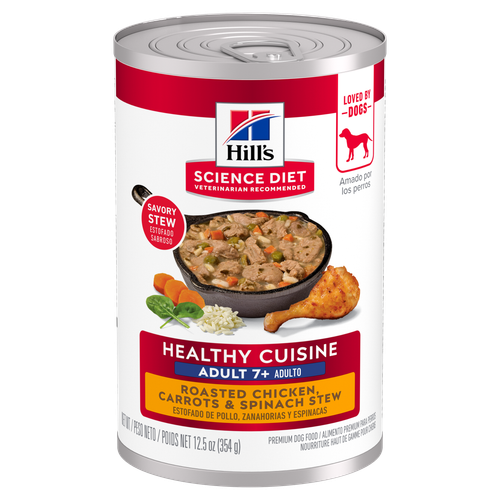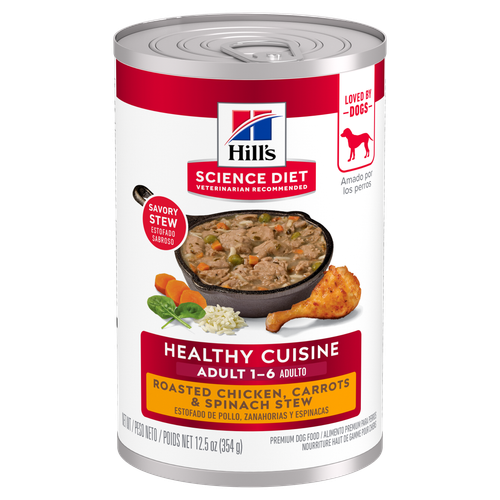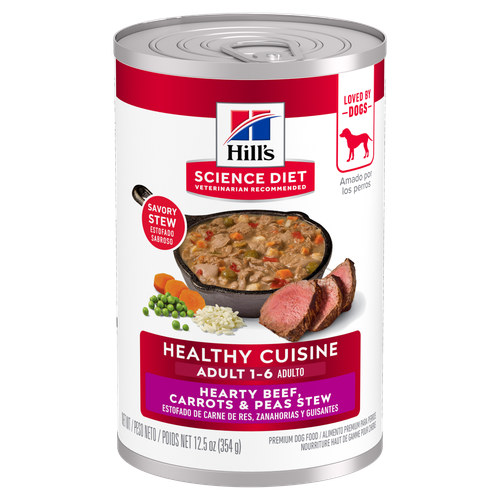
-
Find the right food for your petTake this quiz to see which food may be the best for your furry friend.Find the right food for your petTake this quiz to see which food may be the best for your furry friend.Featured products
 Adult 7+ Healthy Cuisine Roasted Chicken, Carrots & Spinach Stew Dog Food
Adult 7+ Healthy Cuisine Roasted Chicken, Carrots & Spinach Stew Dog FoodDelicious roasted chicken paired with tender vegetables in a succulent stew
Shop Now Adult Healthy Cuisine Roasted Chicken, Carrots & Spinach Stew Dog Food
Adult Healthy Cuisine Roasted Chicken, Carrots & Spinach Stew Dog FoodDelicious roasted chicken paired with tender vegetables in a succulent stew
Shop Now Adult Healthy Cuisine Hearty Beef, Carrots & Peas Stew Dog Food
Adult Healthy Cuisine Hearty Beef, Carrots & Peas Stew Dog FoodHearty beef paired with tender vegetables in a savory stew
Shop NowFeatured products Adult 7+ Indoor Chicken Recipe Cat Food
Adult 7+ Indoor Chicken Recipe Cat FoodSupports energy level and beautiful fur in mature indoor cats
Shop Now Senior Vitality Adult 7+ Tuna & Vegetables Stew
Senior Vitality Adult 7+ Tuna & Vegetables StewImproves Everyday Ability to Get Up & Go
Shop Now Adult Turkey & Liver Entrée Cat Food
Adult Turkey & Liver Entrée Cat FoodPrecisely balanced nutrition with the delicious taste of minced turkey & liver to help fuel the energy needs of cats during the prime of their life
Shop Now -
Dog
- Dog Tips & Articles
-
Health Category
- Weight
- Food & Environmental Sensitivities
- Urinary
- Digestive
- Joint
- Kidney
-
Life Stage
- Puppy Nutrition
- Adult Nutrition
- Senior Nutrition
Cat- Cat Tips & Articles
-
Health Category
- Weight
- Skin & Food Sensitivities
- Urinary
- Digestive
- Kidney
-
Life Stage
- Kitten Nutrition
- Adult Nutrition
Featured articles What Is Littermate Syndrome? Pet Adoption Guide
What Is Littermate Syndrome? Pet Adoption GuideLearn more about littermate syndrome in dogs and cats and how to successfully navigate adoption and early socialization processes.
Read More The Science Behind Our Love for Pets
The Science Behind Our Love for PetsLearn the scientific reasons why we have such strong connections with our pets, and what science says about the love between humans and our furry friends.
Read More How to Properly Mix Wet & Dry Pet Foods
How to Properly Mix Wet & Dry Pet FoodsAn Orange cat eating from a bowl filled with mixed food
Read More -


Cyan is a beautiful color when you see it in the sky on a sunny day, but if you ever notice that your dog's gums have more of a purple or blue tone to them, it may indicate cyanosis, and you should contact or rush to your veterinarian immediately. Not just a color change, cyanosis in dogs is a blue to purple discoloration of the skin or gums due to low oxygenation in these tissues. A number of causes can result in blue skin in dogs, but they all relate to a lowered oxygen level in the blood vessels near the surface of these tissues. Let's take a closer look at this condition.
Clinical Signs of Cyanosis in Dogs
While oxygenated blood that runs in our arteries is red, poorly oxygenated blood carried by our veins is usually blue. When you see blue skin or gums in dogs, their blood isn't getting oxygenated properly. Not only can a dog's tongue and gums turn blue, but other areas where the skin is thin and fur is sparse can also appear blue. These areas can include the groin, abdomen, paws and the tips and inside of the ears.

In addition to blue skin, cyanosis in dogs is usually accompanied by:
- Respiratory distress, such as panting
- Coughing
- Strong abdominal contractions associated with severe respiratory effort
- Collapsing
- Agitation
Some breeds that suffer from cyanosis include short-nosed, or brachycephalic breeds, such as pugs, boxers, bulldogs, Shih Tzus, Pekingese, Lhasa Apsos and English toy spaniels. These breeds are predisposed to respiratory distress in general, especially when overheated.
Remember, some dogs naturally have blackened skin pigmentation and gums. The chow chow is an example of a breed with this pigmentation pattern. Don't confuse this normal blueish-purplish skin and mucous membrane coloration as cyanosis in dogs.


Tasty Tips
Diagnosing Cyanosis in Dogs
If you or your vet notice blue skin in dogs, a diagnosis must be sought quickly. Blue skin in dogs is a sign that your dog is poorly oxygenating — and not an early sign of decreased oxygen levels. Therefore, your vet will likely perform a quick initial physical exam, or your pet may be rushed to the back treatment area right away. This initial exam may include a measurement of the dog's oxygenation levels by placing a small device called a pulse oximeter on an area of your dog, such as the tongue or tip of the ear.
Stabilizing a cyanotic dog is key, and oxygen therapy will be initiated right away. If the cause of your pet's cyanosis can't be determined with a physical exam alone, your vet may consider pursuing diagnostic tests such as basic bloodwork, which may include measuring your pet's blood oxygen levels, chest X-rays, and assessments of heart function. These heart tests are necessary because heart disease is a common cause of respiratory distress in dogs.

According to Canada West Veterinary Specialists, cyanosis is broadly divided into two main categories: central or peripheral causes. With central cyanosis, the entire blood supply is poorly saturated with oxygen. Central cyanosis occurs most commonly with disorders such as heart disease or severe lung disease that impairs your pet's ability to oxygenate their blood properly. In contrast, peripheral cyanosis occurs when the heart and lungs are properly oxygenating your pet's blood, but there is an issue with the delivery of this oxygenated blood to various parts of the body. Most commonly, this occurs with diseases such as blood clots or other issues that result in poor blood flow to parts of the body (such as a bandage that is applied too tightly).
While there are several conditions associated with cyanosis in dogs, some of the more common ones include heart failure, heat stroke, pneumonia and hypothermia.
Treatment and Prognosis for Cyanosis in Dogs
After the dog is stabilized, the cause of the oxygenation failure will determine how to manage the disease in the long term. Some dogs who present with cyanosis have a great prognosis and may never experience blue gums again in the future, such as a dog who was outside during cold weather and suffering from hypothermia.
Puppies and kittens who experience cyanosis are more likely to have a birth defect as the cause. While surgery is often available for many of these pets, the outlook is often poorer in these instances.
Regardless of the prognosis, a dog with blue gums or skin should always be rushed to the vet. This is an emergency situation in all cases. While the cause of cyanosis and the associated prognosis varies, stabilization is the primary goal and is critical.


Dr. Laci Schaible is a small animal veterinarian, veterinary journalist, and a thought leader in the industry. She received her Doctor of Veterinary Medicine from Texas A&M University and her Masters in Legal Studies from Wake Forest University.
Related products



Chicken & Rice Stew with great taste and precisely balanced nutrition to support 5 essential building blocks for lifelong health

Hill's Science Diet Sensitive Stomach & Skin Variety Pack
Related articles

Your dog's coat and skin are a big part of your dog's overall health. Ensure you keep your dog's coat healthy, by following these simple tips.

Wondering where can I buy a dog? Consider adoption and explore the pros and cons of adopting a dog from a breeder versus an animal shelter.

Learn how to help keep your dog's immune system in tip-top shape, including nutritional immune system support for dogs and other strategies.

Discover how the field of dog science is giving us more and more insights into the inner workings of our furry best friends.

Put your dog on a diet without them knowing
Our low calorie formula helps you control your dog's weight. It's packed with high-quality protein for building lean muscles, and made with purposeful ingredients for a flavorful, nutritious meal. Clinically proven antioxidants, Vitamin C+E, help promote a healthy immune system.
Put your dog on a diet without them knowing
Our low calorie formula helps you control your dog's weight. It's packed with high-quality protein for building lean muscles, and made with purposeful ingredients for a flavorful, nutritious meal. Clinically proven antioxidants, Vitamin C+E, help promote a healthy immune system.

